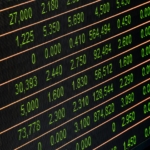Economic Update July 2020
Economic Update – July 2020
by Infocus Author
Within this month’s update, we share with you a snapshot of economic occurrences both nationally and from around the globe.
– The US Federal Reserve continues to support markets
We hope you find this month’s Economic Update as informative as always. If you have any feedback or would like to discuss any aspect of this report, please contact our office.
The Big Picture
The bumper rally in Australian equities starting from the March 23rd 2020 low appears to be pausing as we enter a new financial year. There are many unknowns – not least of which include how the COVID-19 pandemic will playout, and how the November 2020 US presidential election will influence markets.
The financial year just ending (FY20) did produce a moderate negative return of -7.7% for Australian shares even after including dividends being re-invested. But, to put that loss in perspective, it is only the second loss in the 11 financial years since the post-GFC rally started in mid-2009! Moreover, it does not appear to us that the longer run rally will end anytime soon as many central banks are still operating under very loose monetary conditions.
It is very difficult to predict how the COVID-19 pandemic will play out given there are no vaccines or cures yet available – and may not be for another 12 months. There are signs in some regions, and some of the southern US states, that a material second wave is taking hold. Australia has fared comparatively well, however the state of Victoria has placed 30 suburbs of Melbourne back into lockdown due to a rapid increase in localised infections.
Since we now have far more knowledge and available resources than when the virus first struck, we think it is reasonable to assume that authorities will be able to better manage the spread and impact of the virus from here without the almost global shut-down of economies witnessed in the second quarter of 2020.
As restrictions are being relaxed, there are signs that economic recoveries are under way. We argued that the sharp negative growth figures we saw earlier this year – and still in some regions – should not be overly dwelt upon. We take the same measured view about the magnitude of the recovery figures.
In June US retail sales grew by 17.7% for the month and house sales by 16.6%. Australian retail sales grew by 16.3%. And China posted a 6% monthly gain in industrial profits – the first positive results since November! These are, of course, historically very high numbers. Our take-away is not the magnitude of these data points, but the timing. The recovery has started a couple of months before we and most others thought likely. And that is very welcome news indeed.
If the pick-up is faster than most expected, it is no surprise that we infer the market sell-offs into March were likely over-done. Some commentators are saying that the June quarter (Q2) rally was too strong. That is only the case if the over-sold notion is not taken into account. Either way, a strong rally into the end of a quarter (and our financial year) tempts fund managers to lock in some gains for window dressing and tax management purposes.
Until our company reporting season starts in August (and the US second quarter results start soon) we do not have much insight as to what companies really think the future looks like.
It is true that the US has called that their economy went into recession in February of this year. With our 0.3% result for quarter one growth and a likely big negative number for quarter two, we can reasonably conclude that we are in recession too.
However, US and Australia unemployment numbers are lower than one might expect in a ‘normal’ recession. These shut-down induced recessions are very different from the traditional ‘standard’ recession. The IMF has predicted global growth for 2020 to be 4.9% but that needs to be analysed in conjunction with the possible speed of the recovery.
Australian Equities
The ASX 200 had a strong June posting a capital gain of +2.5% which was in line with the world market. However, capital gains for the financial year (FY20) were down 10.9% or 7.7% when re-invested dividends are included.
While FY20 was poor for the Australian index, two sectors stood out as very strong pockets of growth. The health sector gains were +25.7% and the IT sector gains were +18.0%.
We judge the market to be modestly under-priced but that call must be considered in the light of company earnings forecasts and outlooks seemingly lagging behind actual events. This situation should become clearer as our August reporting season gets under way.
Foreign Equities
The S&P 500 gains in June slightly lagged behind the ASX 200 with a gain of +1.8%. However, the US Dow Jones Index had the best Q2 since 1987; the S&P 500 had the best Q2 for 22 years; the Nasdaq broke through 10,000 for the first time and recorded gains of 24.4% in the last 12 months (our FY20). Europe posted the best quarterly gains for five years. Of course, Q1 (the March quarter) was very bad for most indexes so Q2 should not be viewed in isolation.
Bonds and Interest Rates
There has been little movement in official rates because they are effectively at the floor (at zero or negative). However, central banks have been trying to influence longer rates with quantitative easing (QE).
From June, the Fed is now able to purchase individual corporate bonds and it is committed to at least $120bn purchases per month of Treasuries and Mortgage Backed Securities until the end of 2022. That is much bigger than the QE during the GFC. It has also stated that the reference rate will not be increased at least until after 2022.
The governor of the Reserve Bank of Australia (RBA) stated that the official rate will be low for years to come.
These actions by central banks make investing in equities more appealing than they otherwise would be. Some call it the equivalent to a ‘put option’ (or floor) on the market. Volatility will still persist but money has to find a home that will pay a yield. Equities currently have the best chance of producing a reasonable income stream out of the standard asset classes.
Other Assets
Although there is still price volatility in commodities, prices are far more stable than they were a month or two ago. There has been increased commitment to controlling the supply of oil helping those prices stay well away from the May lows.
Austrailia
First quarter GDP growth came in at 0.3% signalling the probable start to (at least) two quarters of negative growth which would be enough to call a ‘recession’ using the simplistic rule of two consecutive quarters of negative growth.
However, it should be stressed that growth over the year was still positive at +1.4%! All is not yet lost.
However, the unemployment rate is still only 7.1% which is well below the levels of previous ‘standard’ recessions. With the economy starting to reopen, unemployment may not worsen much more.
With Prime Minister Morrison launching $1.5bn worth of ‘shovel ready’ infrastructure projects in June, and it seems likely that ‘Job-keeper’ and other such schemes in some form are likely to continue, the government fiscal policy is aimed at supporting economic recovery.
China
China is flexing its muscles over Hong Kong and the US is getting involved. While it might be laudable to come to Hong Kong’s assistance (even trying to bring in Europe) there could be some very bad consequences for trade and global growth should this situation escalate.
Industrial production up +6% bounced back in the latest China data – the first positive since November. Hong Kong re-opened its Disneyland facility – albeit with some restrictions.
Both the manufacturing and services PMIs (Purchasing Managers’ Index) beat expectations. The manufacturing sector expanded for a fourth straight month at 50.9. The services sector PMI was up one point at 54.4 over the previous month.
US
President Trump has slipped well behind Democratic contender Biden in the early election polls. However, Trump leads in ‘dealing with the economy’ so it is hard to predict who will win the election when ‘the chips are down’. If Biden wins, tax increases are on the agenda to address the widening income and wealth inequalities. However, it is unlikely anyone would try to raise taxes while the economy is so fragile.
Europe
There is little doubt that the fortunes of Europe are not as important as they once were considered to be. The possible fallout from a Grexit or a Brexit are no longer major issues. The UK even seems to be in a position to do a trade deal with Europe in July – well before the December 31st 2020 deadline.
Europe’s economic data has been as bad as elsewhere. But Europe is not as key to US and Australian economic success as it was previously. When Europe looked likely to implode (in around 2001-2013), it mattered a lot more.
Rest of the World
Japan was forced to reconsider the re-opening of its economy. The latest industrial output data was 8.4% for the month. Japan has not yet turned the corner as possibly the US and Australia have economically.
China passed laws to control certain aspects of its security relationship with Hong Kong to take effect from July 1st. The US is unlikely to remain quiet on this point and an adverse trade response is quite possible.



